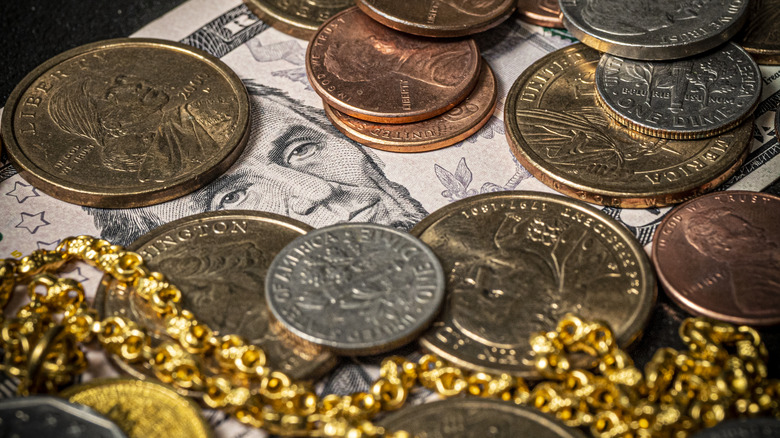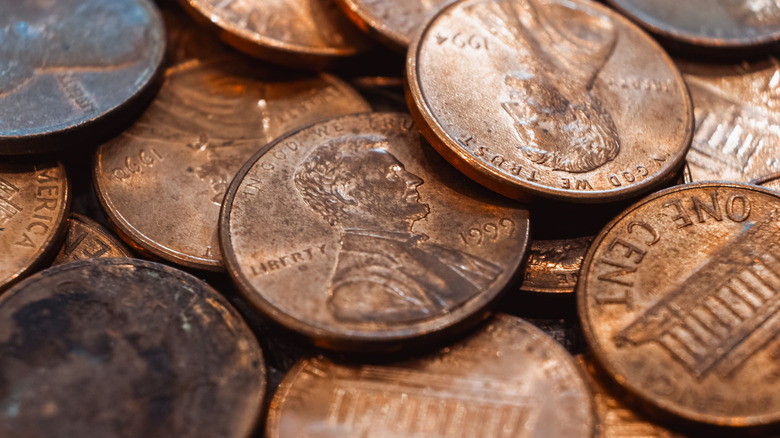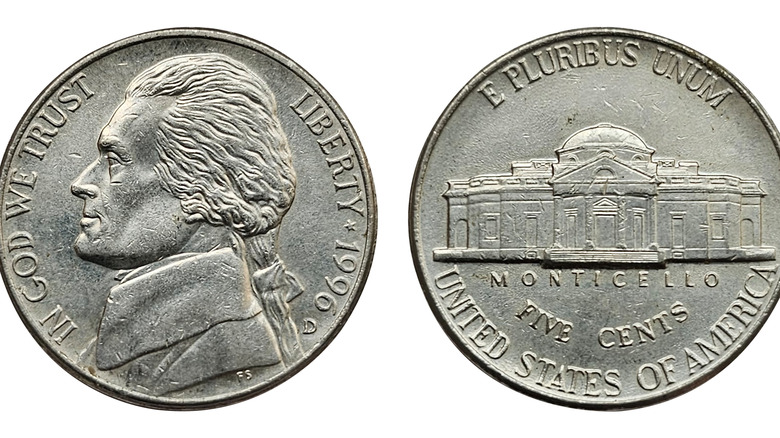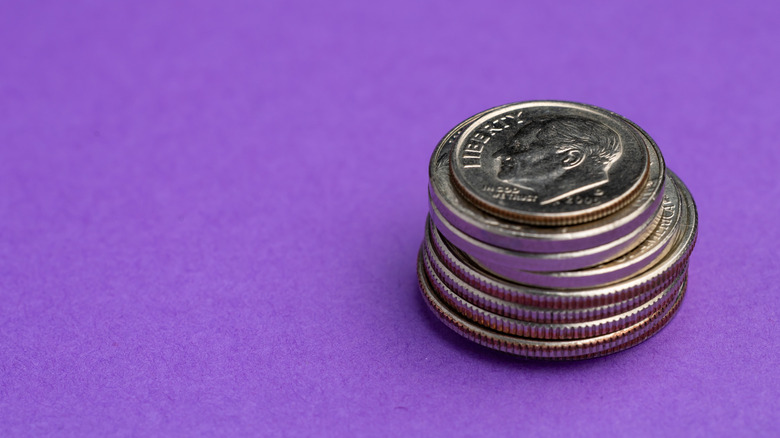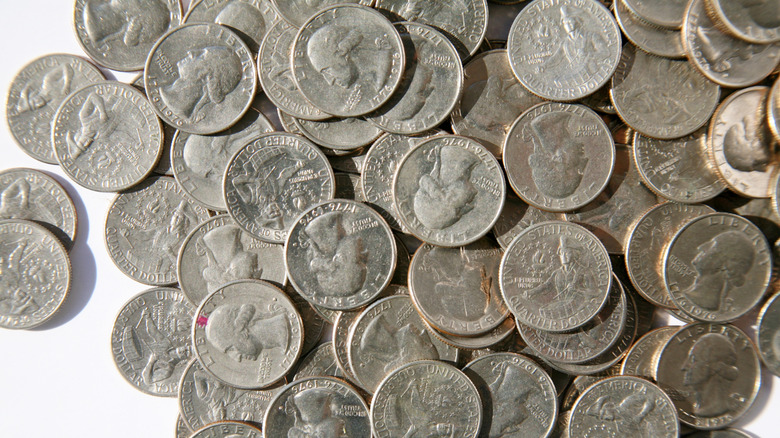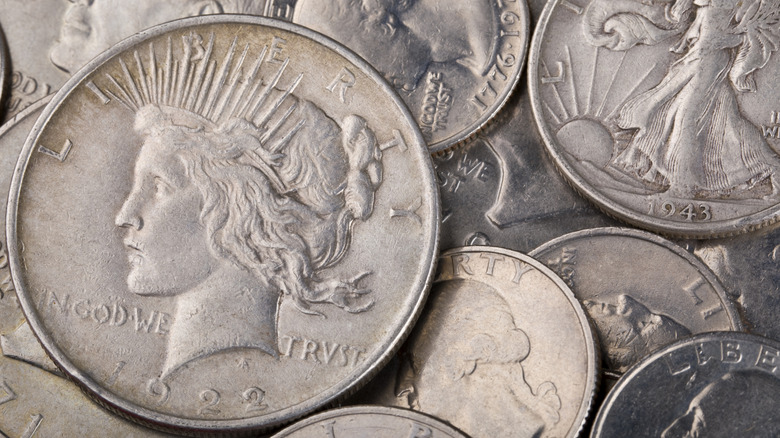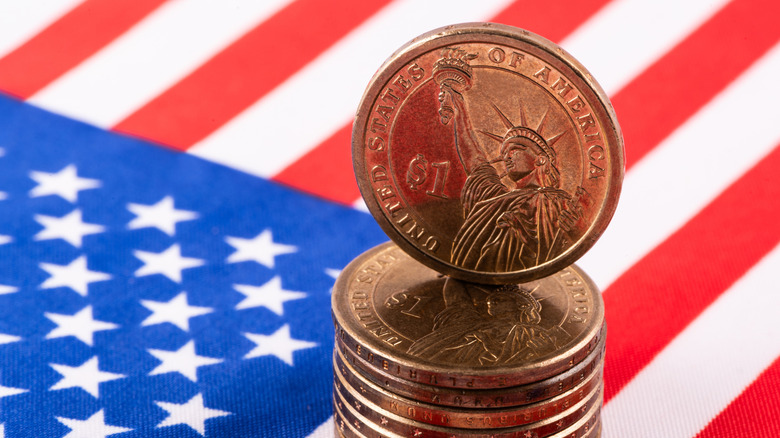Here's How Much It Costs To Make Every Major US Coin
On a Sunday night, right after the Super Bowl, Donald Trump labeled penny production as wasteful and ordered the U.S. Treasury to stop making the coin to cut costs. He said, reported by The Guardian, "Let's rip the waste out of our great nation's budget, even if it's a penny at a time." The last time the U.S. discontinued a coin for regular use was in 1933, which ended the making of denominations like the half-cent, two-cent, and twenty-cent pieces, some of which can be quite valuable now.
You probably have mixed feelings about this decision, same as other people. You might think it's a smart way to modernize our currency and reduce unnecessary government spending. While others cherish the penny as a part of American tradition and worry about issues like changes in cash transactions and price rounding, which might unfairly impact certain groups. Regardless of where you stand, it's important to note that the U.S. Mint, responsible for making both circulating and collectible coins, has a budget of about $5.7 billion. This raises questions: Where does all this money go, and how much does it actually cost to produce each major U.S. coin?
Penny
When the penny was first introduced in 1793, it was made of pure copper, but over time, different metal mixes were used to adapt to economic conditions and by 1982, the Mint switched to a zinc core with a thin copper coating to combat high copper prices. Despite tweaks to the process, the cost of making a penny keeps soaring. Inflation, pricier mining operations, and supply chain snags are all driving up the expense of producing each coin. Today, it costs nearly 4 cents to make a penny.
A penny weighs 2.5 grams and is mostly zinc, making up 97.5% of its makeup. With zinc going for about $2,800 per metric ton and copper at $8,500, the raw materials cost roughly 0.73 cents per penny. While that might not sound like much, the real expenses rack up in labor, minting, and shipping, adding another 2 cents to each coin's cost. So, every penny minted puts the government 1.7 cents in the red, summing up to an annual loss of around $68 million.
Nickel
Since its debut, the nickel has undergone several changes. Today, it's composed of 75% copper and 25% nickel, and it weighs exactly 5.0 grams. Copper, essential in electronics and renewable energy, has seen its price skyrocket recently. Nickel, vital for electric vehicle batteries and stainless steel making, has also become more valuable as demand grows. It now costs about 13.8 cents to produce a nickel, far surpassing its face value of 5 cents. And it's likely to move up.
The price of making nickels swings with the costs of metals, influenced by global trade rules, supply chain hiccups, and world demand. The U.S. Mint has thought about swapping out the metals in nickels to slash costs. But they couldn't do that because the precise weight and electromagnetic traits of nickels are key for vending machines, transit fares, and other automated payments to work smoothly. Tweaking the materials might mess these systems up and businesses that count on stable coin designs have put up a fight against changes before.
Dime
Little yet vital, the dime is an element of U.S. money that has an interesting history molded by cost, composition, and efficiency. Producing a dime today costs roughly 5.2 cents, hence the U.S. Mint gains 4.8 cents every dime — a process known as "seigniorage." This is so because, compared to the silver it was formerly composed of, the dime is made of 91.67% copper and 8.33% nickel, two rather cheap metals. Originally meant to stop coin shaving, each dime weighs 2.268 grams.
Until 1965, dime components were 90% silver; growing prices drove a change to the present more reasonably priced copper-nickel-clad composition. Copper runs roughly $8,500 per ton right now, and nickel runs roughly $17,000 per ton. For each dime, the raw materials alone cost about 2.09 cents. When you add in labor, minting, and distribution, the total cost comes to 5.2 cents per coin. Still, making dimes is still pretty cost-effective. Right now, there are no plans to change how they look or what they're made of.
Quarter
The quarter is one of the most commonly used coins in the U.S., vital for vending machines, toll systems, and everyday transactions. As of 2024, it costs 12.3 cents to make each quarter, which is more than double the cost of producing a dime. Its size, weight, and the materials it's made from are the main reasons for this higher cost, some versions of which are now worth a ton of money.
Made of the same alloy as the dime, the quarter is about 2.5 times heavier than the dime and uses more raw materials, measuring 24.26mm in diameter and weighing 5.670 grams. Its larger size means it requires more metal per coin, which directly bumps up manufacturing costs. Yet, the quarter remains a valuable coin for trade and has been central to several commemorative projects, like the 50 State Quarters series, which spiked public interest in coin collecting. Financially, each quarter, valued at 25 cents, generates about 12.7 cents in seigniorage, which the Mint counts as profit.
Half Dollar
Half-dollar coins are some of the least-used coins in the U.S. today, but they still hold a special place in American numismatics. Unlike quarters or dimes, they rarely show up in everyday transactions, but the U.S. Mint still produces them for collectors and special occasions. Since they aren't made in large quantities, the fixed production costs are spread across fewer coins, making each one more expensive to produce (here's how to spot rare coins that could be worth a lot tomorrow)
Each half-dollar coin costs about 34 cents to produce. This keeps the half-dollar financially viable for the Mint, as it's made for less than its face value, unlike the penny and nickel. Originally, up until 1965, half-dollars were composed of 90% silver, then 40% silver until 1971. Since then, they've been made of 91.67% copper and 8.33% nickel. The half-dollar stands out as a larger and heavier coin compared to others in circulation, requiring more raw materials per unit. Its bigger size also affects the minting process, increasing the time, energy, and wear on manufacturing equipment.
Dollar Coin
The U.S. dollar coin is a standout in the currency lineup, known for its unique makeup and rich history, but it's rarely seen in daily spending. The latest versions, the Presidential Dollar and the Sacagawea/Native American Dollar, were launched with the idea of nudging people towards using coins instead of bills. It doesn't seem to have had that much effect but the Mint keeps churning them out, mainly for collectors who love a good coin story.
In 2023, it cost just 12.43 cents to make a dollar coin, factoring in raw materials, labor, and minting. This marks a slight drop from previous years. The ingredients of the dollar coin are budget-friendly; there's no real gold, but they sport a golden glow thanks to a blend of 88.5% copper, 6% zinc, 3.5% manganese, and 2% nickel. This sturdy mix not only keeps costs down but also gives the coins a distinct look and feel, setting them apart from quarters.
Launched in 2000, the Sacagawea Dollar was born from the ashes of the unsuccessful Susan B. Anthony Dollar from the late 1970s. The goal was to create an attractive coin that people would actually want to use. However, the rise of digital payments and the enduring love for paper dollars have kept it from becoming a staple in daily transactions. This record is similar to the Presidential Dollar Series, which ran from 2007 to 2016 and featured U.S. presidents.
